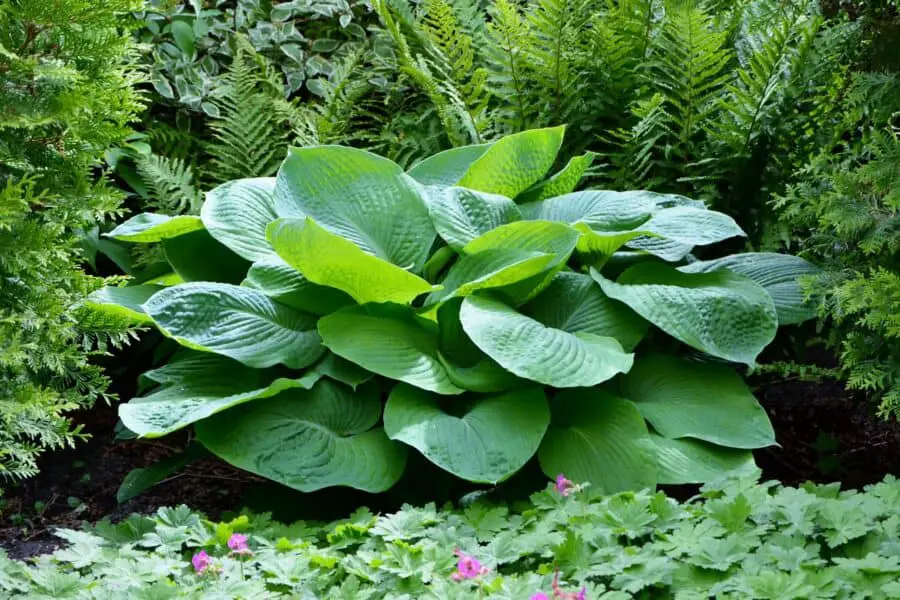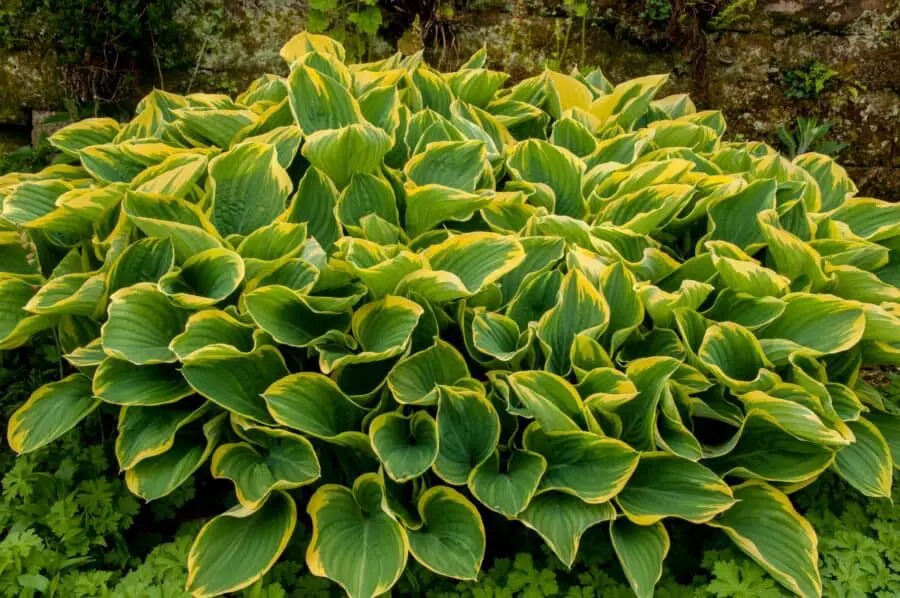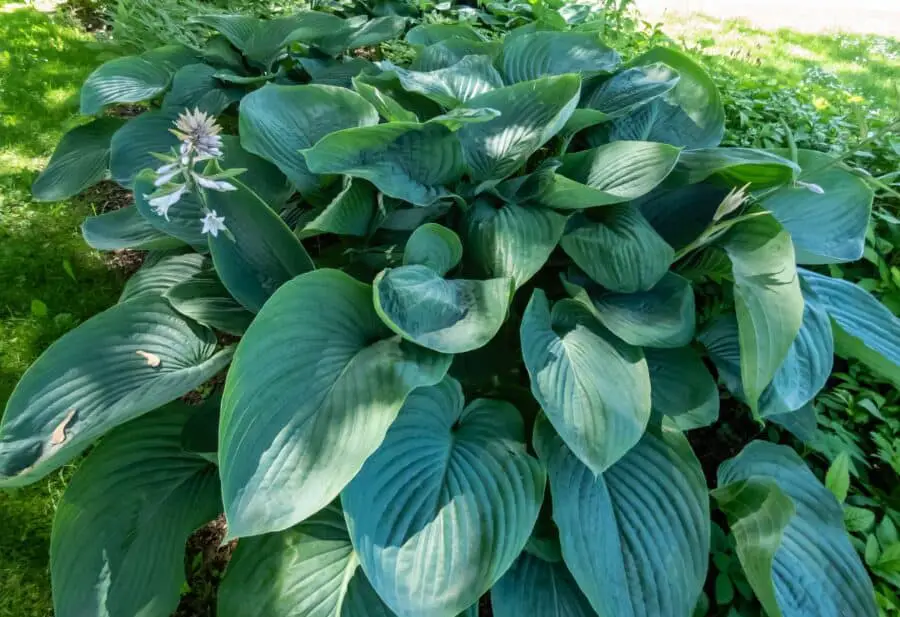Giant hosta plants are a popular choice for gardeners looking to add a bold statement to their landscape. As defined by the American Hosta Growers Association, giant hostas are those that exceed 30 inches in height. The American Hosta Society lists hostas with a leaf size of 120 square inches or more as giant. Some giant hostas can grow up to 4 feet tall and 6 feet wide, with leaves that can reach up to 18 inches wide.
One of the main reasons giant hostas fascinate gardeners is their impressive size and striking foliage. They can add a dramatic element to any garden and serve as a focal point in a landscape design. Their large leaves come in a range of colors and textures, from blue-green to chartreuse to gold and variegated. They can be smooth or textured, corrugated or ruffled.
In addition to their aesthetic appeal, giant hostas also have practical benefits. They can help prevent soil erosion on slopes or hillsides, retain moisture in the soil, and attract beneficial insects like bees and butterflies.
Giant Hostas in the Landscape
Giant hostas are a popular choice for adding texture, color, and interest to the landscape. With their large, showy leaves and impressive size, they can serve as a dramatic focal point or provide a lush, green backdrop for other plants. They are ideal for shady areas where other plants may struggle to grow, and can be used in a variety of ways to create a stunning garden design.
One of the benefits of using giant hostas in the landscape is their versatility. They come in a range of sizes, colors, and textures, allowing gardeners to choose the perfect cultivar for their specific needs. Some giant hostas have blue-green leaves, while others have bright green or variegated foliage. Some have large, bold leaves, while others have more delicate, lacy foliage.
Another benefit of giant hostas is their low maintenance requirements. They are relatively easy to grow and care for and can tolerate a wide range of soil types and moisture levels. They also do well in shady areas where other plants may struggle, making them a great choice for creating a lush, green garden in areas with limited sunlight.
When incorporating giant hostas into the landscape, it’s important to consider their size and placement. Use them as a dramatic focal point in the garden, or as a backdrop for other plants. They also work well in containers, where their enormous size and impressive foliage can create a stunning display.
Overall, giant hostas are a versatile and low maintenance plant that can add texture, color, and interest to any landscape. With their impressive size and showy foliage, they are sure to make a statement in any garden design.
Companion Plants for Giant Hostas
Giant hostas can be the centerpiece of a beautiful garden bed, but they also pair well with other plants that can complement their size, texture, and color. Here are some companion plants that you can plant alongside giant hostas:
Ligularia – This shade-loving plant has large, bold leaves that complement the size and texture of giant hostas. It also produces tall spikes of yellow or orange flowers that can add a pop of color to the garden
Rodgersia – This plant has large, textured leaves that create a beautiful contrast with the smooth leaves of giant hostas. It also produces tall spikes of pink or white flowers that can add height to the garden.
Astilboides – This plant has large, round leaves that can add a unique shape to the garden. It also produces tall spikes of white flowers that can create a dramatic effect when planted alongside giant hostas.
Solomon’s Seal – This plant has arching stems with small, bell-shaped flowers and pairs well with hostas in woodland gardens.
Japanese Maple – This tree has delicate, lacy foliage in shades of red, orange, and green that can provide a beautiful backdrop for hostas.
Hydrangea – This plant has large, showy blooms in shades of pink, blue, and white that can complement the foliage of giant hostas.
Creative Ways to Use Giant Hostas in Landscaping and Garden Design
Create a giant hosta garden bed: Plant a variety of giant hosta varieties in a dedicated garden bed to create a lush focal point in the garden. Mix and match different leaf shapes and colors to create a dynamic display.
Use giant hostas as a backdrop: Plant giant hostas behind smaller plants to create a dramatic backdrop. This works especially well in a shade garden, where the large leaves of the hostas can create a beautiful backdrop for smaller, shade-loving plants.
Use hostas in a water garden: Plant giant hostas around the edge of a water garden for a lush, tropical look. Choose cultivars with blue-green or gold leaves for added interest.
Use hostas in a woodland garden: Plant giant hostas in a woodland garden with other shade-loving plants like trilliums, mayapples, and wild ginger for a natural look.
Use hostas in a container garden: Plant a large, bold hosta in a container with other shade-loving plants like ferns and heuchera for a stunning display.

Some of the Best Giant Hostas
How to Grow Giant Hostas
The basics of growing giant hostas is no different than growing any other hosta.
So, what is different?
Watering, as these plants get established and growing well, you don’t want to miss a watering cycle. This is especially true when it comes to growing these giants in containers.
To keep from moving these hostas when they get big, you need to remember how big giant hostas get. Also realize that if they are really happy with their location, they can grow larger that the books say. Avoid tight quarters.
You should check the interior of these giant hostas occasionally for pests or diseases. In the nursery, I always spot checked a few plants in each block. It gives you a head start if a problem pops up.
If down the road you decide to dig up and divide a mature giant hosta, you will discover the hard part of growing these big plants.
Have fun, hostas are easy to grow and forgiving plants.
When to Plant a Giant Hosta
The best times of the year to plant a giant hosta are no different from planting any other hosta.
Early spring is the best time, followed by fall with the last planting date at least 6 weeks before the first frost.
Summer planting is more difficult because of the hot summer sun. If you are planting a small plant, say a one to five gallon sized plant, you shouldn’t have any problems.
Larger plants with a lot of foliage can become stressed in bright shade.
If the plant is showing signs of stress, give it more protection with some movable shade to reduce the sunlight reaching the plant.
A piece of shade cloth attached to a frame or temporary poles for a couple of weeks is a simple solution.
Dividing Giant Hostas
Dividing giant hostas can be a challenging task, as these plants can grow quite large and have extensive root systems. Then there is the dilemma. It’s so big and beautiful and it’s just too big now.
Here are some tips for dealing with dividing these large plants:
Choose the right time: The best time to divide giant hostas is in the early spring, just as fresh growth is beginning to emerge. This will give the plant plenty of time to establish itself before the hot summer months.
Doing your dividing in the early spring also means you don’t have to deal with all that top growth and giant leaves that always get in the way. Dividing a mature giant hosta is a major effort is I always try to make it as easy as possible. All the steps to dividing hostas are here.

Giant Hostas in Pots
You can easily grow giant hostas in pots with a bit of care and attention. Here are some tips for growing giant hostas in pots and the difficulties that can be encountered:
Big Plants = Big Pots
Pots need to be sized to the size of the plant you are putting in the pot, not necessarily the full grown size of the hosta.
You need to leave space for the roots to grow into, but not so much space that it becomes easy to over-water the plant and kill it.
Since it takes years for a giant hosta to mature, you are likely to go through more than one size pot on this adventure.
Root Bound Plants
Giant hostas can quickly outgrow their pots and become root bound, which can stunt their growth and cause them to wilt. Repot or divide your hostas every few years to prevent this from happening.
Watch Your Watering
When your plant is first potted, there are lots of soil waiting for new roots. Be careful not to over-water the plant while it is getting established.
Over time roots fill the pot, leaving less room for water, causing you to water more often and making to think about dividing the plant or potting it into a larger container.
When growing mature giant hostas in pots, it is important to consider the size of the container. These plants can easily outgrow pots that are 36 or 48 inches in size, which can make them very heavy and difficult for the gardener to move and require more effort to maintain.
For all the juicy details about containerized hostas, see our article Yes! You Can Grow Hostas in Pots.
Fertilizing Giant Hostas
Giant hostas require regular fertilization to thrive, but they do not need to be treated differently than other hostas in the garden.
Giant hostas will use more fertilizer than small hostas. Good garden soil rich in organic matter is your key ingredient for success. Using supplemental fertilizer after the first flush of leaves and again in early summer makes an excellent finishing touch.
Fertilizing giant hostas or any hostas in containers starts with quality potting soil. The easiest way to add nutrients is with liquid or slow-release fertilizers.
An important tip: If you are not watering your hostas properly, you will not get the maximum results from your fertilizing efforts.
If you want to be dipped in details about using fertilizer for hostas, see our article How to Use Hosta Fertilizer.
Common Pests and Diseases That Affect Giant Hostas
Giant hostas are subject to the same disease and pest problems that all hostas suffer from. One exception is that large, dense hostas can mask early problems that start out at the interior of the plant. An occasional look inside is the best way to stop surprises, especially in hot humid weather.

Growing Giant Hostas in Warm Climates
While most giant hostas prefer cooler climates, there are some varieties that can thrive in warmer areas (zones 8, 9, and 10). Here are a few varieties of giant hostas that are suitable for warm areas:
‘Sagae’ – This is one of the most popular giant hosta varieties and can grow up to 30 inches tall and 54-60 inches wide. It has blue-green leaves with yellow margins and can tolerate some sun.
‘Sum and Substance’ – This is another popular giant hosta variety that can grow up to 3-4 feet tall and 5-6 feet wide. It has large, chartreuse leaves and can tolerate some sun. Requires less cold dormancy than many hostas
‘Empress Wu’ – This is one of the largest giant hosta varieties, with leaves that can grow up to 18 inches wide and plants that can reach up to 3-4 feet tall and 6 feet wide. It has blue-green leaves and can tolerate some sun.
‘Blue Angel’ – This giant hosta variety can grow up to 3 feet tall and 5-6 feet wide and has blue-green leaves that can tolerate some sun (you will lose some of the blue color). Requires less cold dormancy than many hostas.
‘Frances Williams’ – This giant hosta variety can grow up to 24-30 inches tall and 4-5 feet wide and has blue-green leaves with yellow margins. It can tolerate some sun.
When growing giant hostas in warm areas, it’s important to provide them with enough shade and moisture to prevent them from drying out. It’s also important to choose varieties that can tolerate some sun and heat.
The biggest downfall of growing hostas in warm climates is the lack of cold to make the plants go dormant.
The exact amount of cold dormancy required for hostas can vary depending on the specific cultivar and the climate in which they are grown. In general, hostas require a period of cold temperatures ranging from 35 to 45 degrees Fahrenheit for at least four to six weeks in order to break dormancy and begin growing again in the spring.